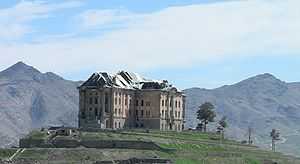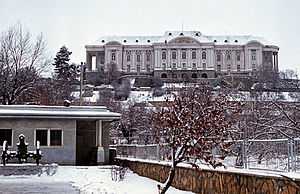Tajbeg Palace


Tajbeg Palace or Tapa-e-Tajbeg Palace (Persian: قصر تاج بيگ ;Pashto: د تاج بېګ ماڼۍ Palace of the large crown) is a Palace built in the 1920s and located about ten miles (16 km) outside of the center of Kabul, Afghanistan. The stately mansion sits atop a knoll among foothills where the Afghan royal family once hunted and picnicked. It should not be confused with Darul Aman Palace, which is about 1.3 kilometres (0.81 mi) northeast from Tajbeg.
Built to house the royal family, Tajbeg Palace is one of the most impressive landmarks of "Darulaman," newly created during the era of Amānullāh Khān by a team of European architects in an attempt to establish a new seat of government and modernize Afghanistan, both of which ultimately failed when religious conservatives forced Amānullāh from power and halted his reforms, leaving the palace in ruins as it has been for much of its existence.[1]
Etymology of the Words Taj und Beg
Taj (Persian: تاج ) means Crown and Beg (Persian: بيگ ) means large. The Altaic Kings or princes such as Turkmens, Uzbek, Hazara had Bay or Beg in the end of their names, their wives Begum. The Timurid dynasty and Moguls made use of Beg (by men) like Qanandar Beg and Begum (by women) like Arjumand Banu Begum or Mumtaz Begum, Noor Jahan Begum etc.) although the Great Mogul in Kabul, Agra and Delhi preferred Persian titles such as Shah Jahan (King of the World), Alamgir (World Conqueror), Jahangir (World Conqueror).[2]
History
Not far from the castle or Tapa e Taj Beg (Taj Beg hill) - German construction manager built the castle - a palace for the Queen of the Timurid is said to have been found a long time ago. Terrace garden design was preferred by Timurids and Moguls. Today some ruins remain. The Dynatie the Timurids and their successors, the Mogul have kinship relations with the Pashtun tribes of Abdali Durrani and later Yussufzai. The daughter in Law of Ahamd Khan Abdali (the wife of Timur Shah Durrani) was the daughter of Alamgir II.
According to some historians this palace to have been renovated by Zaman Shah in 1210 H. (1795), which was destroyed in military conflicts. Here are ruins to see from ancient times. Foreign soldiers of ISAF have included some pictures of the Runien of the former castle.[3] In many historical sites in Afghanistan try the current dynasties, reduce the historical merits of their predecessors.
On December 27, 1979, the Union of Soviet Socialist Republics launched its invasion of Afghanistan. That evening, the Soviet military launched Operation Storm-333, in which some 700 troops, including 54 KGB spetsnaz special forces troops from the Alpha Group and Zenith Group, stormed the Palace and killed President Hafizullah Amin, who resided there.
During the Soviet war in Afghanistan it served as the headquarters of the Soviet 40th Army. The palace was severely damaged after the Soviet withdrawal, when different mujahideen factions fought for control of Kabul.
The Afghan government, in conjunction with the German government, has drafted plans of renovating the palace for official use. The plan requires funds from private donations from wealthy Afghans. There are similar plans for Darul Aman Palace, which is close by, to be rebuilt and used as the building for the Parliament of Afghanistan.[4]
See also
References
| Wikimedia Commons has media related to Tajbeg Palace. |
- ↑ SketchUp Buildings: Buildings Uploading on July 19th
- ↑ Fayz Muhammad Katib Hazarah: Siraj Al-tawarikh (English the history of Afghanistan) 6 Vol. Set, ed. from and translat of R. D. Mcchesney and Mohammad Mehdi Khorrami, Brill's E-Book, 2012
- ↑ http://afghanistanmylasttour.com/tag/tajbeg-palace/ 14th century Mongul ruins, the historical Taj Beg Palace
- ↑ http://www.everywheremag.com/places/4482
External links
| Wikimedia Commons has media related to Darul-Aman Palace. |
Coordinates: 34°27′17.38″N 69°6′48.04″E / 34.4548278°N 69.1133444°E